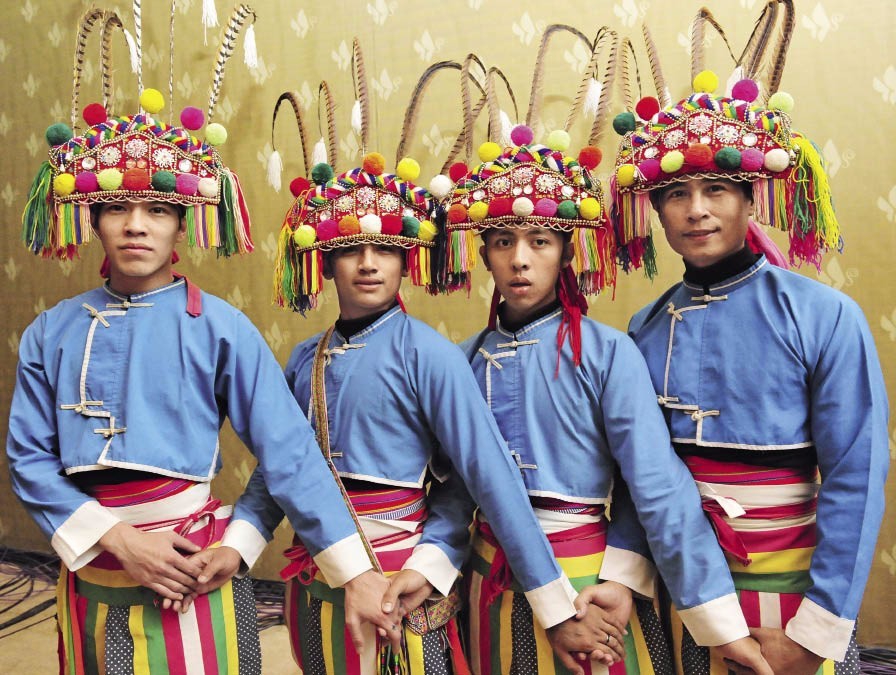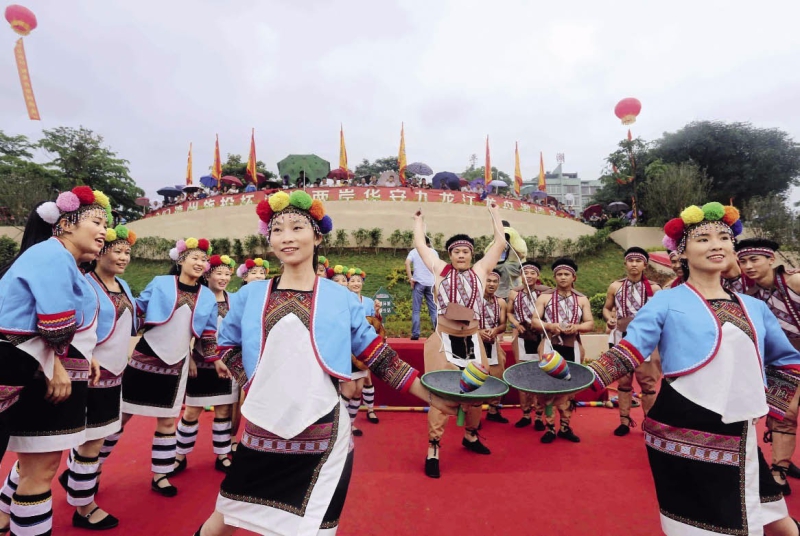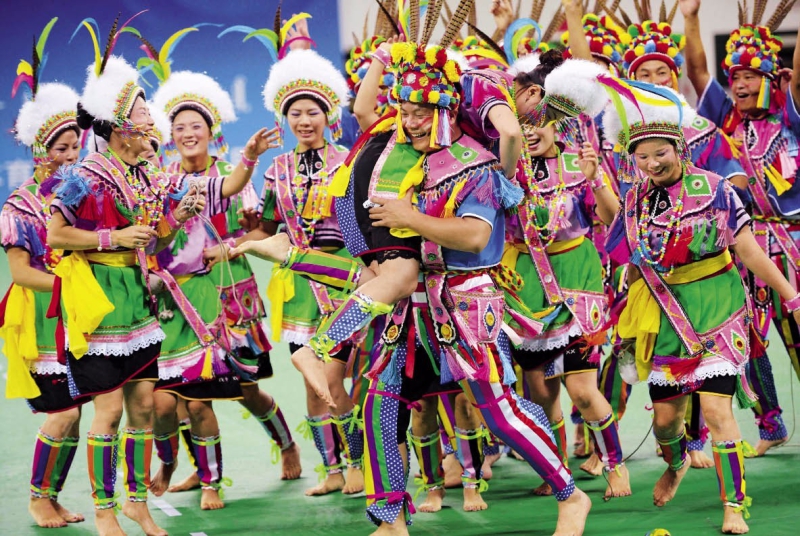GUO ZHIDONG is a researcher of traditional culture at the No. 93 Courtyard Museum.

Performers donned in folk costumes of the Gaoshan ethnic group.
The features of traditional Gaoshan costumes are decided by geographical environment, climate, and other natural factors as well as aesthetic tastes. The costumes are diverse and rich in colors. In general, the Gaoshan people prefer to make their traditional costumes with bright colors, mainly in red and yellow, and accentuate them with black.
The styles of the costumes have strong regional features. Tribal clothing in different regions can be roughly classified into three main types.
In the northern region, men’s clothing as represented by Atayal, Saisiat, and northern Amei people mainly consists of sleeveless shirts, shirt-fronts, shawls, and belts. Their sleeveless shirts are generally made from narrow strips of linen, similar to modern buttonless waistcoats in style. They can be long or short. The long-style ones reach to the knees when worn, while the short ones only reach to above the waist. Men in the region are also accustomed to wearing leather hats or pointed rattan hats and hanging a twill cloth over the front of their chests. With the exception of summer, men often wear a rectangular shawl, which is usually sewn from four narrow pieces of linen cloth. When worn, it is knotted over the wearer’s left shoulder, which looks similar to cassocks worn by Buddhist monks. A striped piece of linen cloth is often worn around the waist as a waist skirt. This style of attire gives the man a heroic appearance.

Female dancers of the Gaoshan ethnic group.
In the central region, men’s clothing more commonly consists of deerskin vests, small bags on the chest and waist area, shirt-fronts, and black sarongs. The category is mainly represented by costumes of the Tsou and Bunun people. The back of the vest is a whole piece of buckskin, and the open front is made of two smaller pieces. A square bag can often be seen hanging over the front chest area, having geometric patterns embroidered on it as decorations. The chest bag can be used as a mere accessory, while at the same time serves a very practical purpose of carrying small items, such as betel nuts or tobacco pipes. Men in this area often hang a triangular bag around their waists, called the “waist bag.” This style of attire is what they wear every day, while during festivals, their style of costumes is more solemn and formal. Usually, they add a braided and embroidered shirt and drape a black sarong around the waist, which is then decorated with various exquisite accessories.
The most common types of clothing in the southern region are mainly long-sleeved tops with open fronts, waist skirts, leggings, and black kerchiefs. This category is mainly represented by the men’s clothing of Paiwan, Puyuma, Rukai, and southern Amei tribes. Men in this region like to wear long-sleeved tops with delicate lace and patterns on the sleeves, collars, and lower hem, so that the whole attire looks bright and colorful. Men also usually tie a half-waist apron or wide waist belt around their waist, and the two ends of the waist belt hang down the front part of the skirt. In some tribes where social classes are clearly delineated, nobles also wear black cotton leggings, while average people wrap their heads with black kerchiefs.
Gaoshan women usually match a short shirt with a long skirt or pants covered with an apron-like skirt. Compared with the style of clothes worn by men, women’s attire is more sophisticated and the craftsmanship used to make them is more complicated.

Members of the Gaoshan ethnic group perform spinning top during the National Traditional Games of Ethnic Minorities.
Gaoshan women of the Suya, Saisiyat, Tsou, and Amei tribes are accustomed to wearing long-sleeved shirts and long skirts. The placket and sleeves of their tops are usually embroidered with exquisite decorative patterns. Gaoshan women of Bunun, Rukai, and Paiwan tribes are accustomed to wearing longer tops with tight-fitting sleeves. The sleeves are decorated with embroidered patterns on the hem. The tops are usually matched with pants covered by an apron-like skirt. The pants are unique and made from a pair of blue or black square cloth.
Gaoshan women are good at weaving and embroidering. They wove cloth with various patterns in the past. Snake patterns were frequently seen on traditional clothes. It was a result of their living environment and totem. The Gaoshan people believe that the snake is the incarnation of their ancestral god and therefore worship it.
People of each tribe of the Gaoshan ethnic group, regardless of gender, attach great importance to various kinds of decorative ornaments they wear with their clothing. With the passing of time, the ornaments have gradually become mere decorative jewelry from the earliest representations of totem worship. Interestingly, Gaoshan men wear more jewelry than women do.
The jewelry is made from natural materials ranging from shells, animal teeth, animal skins, feathers, flowers, and glass beads. Among these materials, shells seem to be quite popular. The industrious and intelligent Atayal people are skilled in using shells to make decorations. The fineries ornamented with shell decorations they make are extremely impressive. They select high-quality giant clam shells, cut them into small pieces, polish the pieces into perforated shell beads, then make them into strings, and finally sew these beads on the hems and other parts of their costumes. Each of the shell finery could use tens of thousands of shell beads, which are woven together with complicated techniques. It takes time and much energy to make such finery. For this reason, the attire is very precious. The best costume made from shells is often only worn by tribal leaders during major formal events.
A unique living environment and aesthetic tastes have created the colorful costume culture of the Gaoshan people. This bright and beautiful costume art has also greatly enriched China’s costume culture.
GUO ZHIDONG is a researcher of traditional culture at the No. 93 Courtyard Museum.